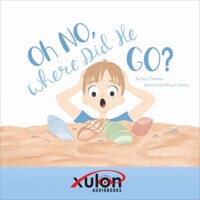Title: Oh No, Where Did He Go?
Subtitle: Understanding how children handle death and loss
Author: Kay E. Thomson
Illustrator: Macey K. Donley
Publisher: Xulon Press Elite
ISBN: 978-1-6628-2170-7
Pages: 23
Genre: Illustrated Children’s Story / Grievance / Self-Help / Christian
Reviewed by: Barbara Miller
Pacific Book Review
 Author Kay E. Thopson has created a story which will teach youngsters about death and dying, the concept of Heaven, and Eternal Life which will come to us once we put our faith in God. All of this is done by juxtaposing a story about a hermit crab missing from an aquarium, as the young boy, JT, exclaims, “Oh no, where did he go?”
Author Kay E. Thopson has created a story which will teach youngsters about death and dying, the concept of Heaven, and Eternal Life which will come to us once we put our faith in God. All of this is done by juxtaposing a story about a hermit crab missing from an aquarium, as the young boy, JT, exclaims, “Oh no, where did he go?”
The names of the cast of characters are many, suggesting, as the author acknowledges at the end, this is based upon a true story. Readers are taken to a situation to solve a mystery; where did Henry, a very special Hermit Crab go when JT found his shell empty? After searching all around, yes, they do find Henry, as he moved into a larger shell outgrowing the one he was in. JT, his brother Doug, his sister Katie, and some of their cousins were shown this valuable lesson. The author gives recognition to Dr. Craig Kraft for providing the analogy of the hermit crab to the theme of the story.
The main thrust of the story is when Grandpa dies. JT, along with his family, grieve the loss. Much of the ceremony of a funeral is new to him, and JT cannot figure out how Grandpa will ever get out of the coffin to go to Heaven, yet alone the hole in the ground they placed him in and covered up with grass. They are told, “The difference is that when God gives us a new body, it is in Heaven. Grandpa is in his new body today. It is a perfect body, and he is in Heaven with Jesus, enjoying his new body and his new home.”
Dealing with the loss of a loved one is something everybody will need to cope with at one time or another. Oh No, Where Did He Go? is a valuable lesson, done in a very elegant way. It shows the reactions of a large family to the death of an elder. This book, with its illustrations and text, brings to life a window into the way one family deals with loss, and provides a template for other children to learn from.


